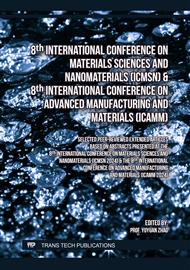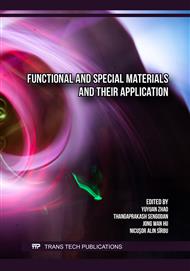[1]
Duan, X., Chen, Hl. & Guo, C. (2022). Polymeric Nanofibers for Drug Delivery Applications: A Recent Review. J Mater Sci: Mater Med 33
DOI: 10.1007/s10856-022-06700-4
Google Scholar
[2]
Deng X, Gould M, Ali MA. (2022). A review of current advancements for wound healing: Biomaterial applications and medical devices. J Biomed Mater Res. 110(11): 2542-2573
DOI: 10.1002/jbm.b.35086
Google Scholar
[3]
Usha Sayed, Ishika Deshmukh .(2021). Application of Herbs for Wound Dressings – Review. Int. J. Adv. Sci. Eng. Vol.7 (3) 1843-1848
DOI: 10.29294/IJASE.7.3.2021.1843-1848
Google Scholar
[4]
Nur Athirah Abdullah and Khairunnadim A. Sekak. (2023). Fabrication, Characterization and Release Profile of Aloe Vera Extracts/PVA Composite Electrospun Nanofiber. International Journal of Nanoelectronics and Materials Vol. 16 (4), 759-770.
DOI: 10.58915/ijneam.v16i3.1342
Google Scholar
[5]
Alven, S., Sindi Prescila Ndlovu, & Aderibigbe, B. A. (2023). Electrospun Cellulose- and Derivatives-Based Nanofibers Loaded with Bioactive Agents for Wound Dressing Applications. 725–752
DOI: 10.1007/978-981-99-2119-5_24
Google Scholar
[6]
Surip, S. N., Aziz, F. M., & Sekak, K. A. (2019). Pineapple Leaf Fibers (PALF)/ Polyethylene Terephthalate (PET) Electrospun Nanofibers: Effect of Ratio on Chemical & Morphological Properties. International Journal of Engineering and Advanced Technology, 9(1), 5631–5638
DOI: 10.35940/ijeat.a3038.109119
Google Scholar
[7]
Liu, X., Xu, H., Zhang, M., & Yu, D.-G. (2021). Electrospun Medicated Nanofibers for Wound Healing: Review. Membranes, 11(10), 770
DOI: 10.3390/membranes11100770
Google Scholar
[8]
Hanumantharao, & Rao. (2019). Multi-Functional Electrospun Nanofibers from Polymer Blends for Scaffold Tissue Engineering. Fibers, 7(7), 66
DOI: 10.3390/fib7070066
Google Scholar
[9]
Blessy Joseph, Robin Augustine, Nandakumar Kalarikkal, Sabu Thomas, Bastien Seantier, Yves Grohens. (2019). Recent advances in electrospun polycaprolactone based scaffolds for wound healing and skin bioengineering applications, Materials Today Communications, Vol.19, 319-335.
DOI: 10.1016/j.mtcomm.2019.02.009
Google Scholar
[10]
Yang, Y., Du, Y., Zhang, J., Zhang, H., & Guo, B. (2022). Structural and Functional Design of Electrospun Nanofibers for Hemostasis and Wound Healing. Advanced Fiber Materials, 4(5), 1027–1057
DOI: 10.1007/s42765-022-00178-z
Google Scholar
[11]
Saddiq, A. A., & Huda Ahmed Alghamdi. (2018). Aloe vera extract: A novel antimicrobial and antibiofilm against methicillin resistant Staphylococcus aureus strains. PubMed, 31(5(Supplementary)), 2123–2130
Google Scholar
[12]
Sánchez, M., González-Burgos, E., Iglesias, I., & Gómez-Serranillos, M. P. (2020). Pharmacological Update Properties of Aloe Vera and its Major Active Constituents. Molecules, 25(6), 1324
DOI: 10.3390/molecules25061324
Google Scholar
[13]
Jančič, U., & Gorgieva, S. (2021). Bromelain and Nisin: The Natural Antimicrobials with High Potential in Biomedicine. Pharmaceutics, 14(1), 76
DOI: 10.3390/pharmaceutics14010076
Google Scholar
[14]
Dong, Y., Zheng, Y., Zhang, K., Yao, Y., Wang, L., Li, X., Yu, J., & Ding, B. (2020). Electrospun Nanofibrous Materials for Wound Healing. Advanced Fiber Materials, 2(4), 212-227
DOI: 10.1007/s42765-020-00034-y
Google Scholar



